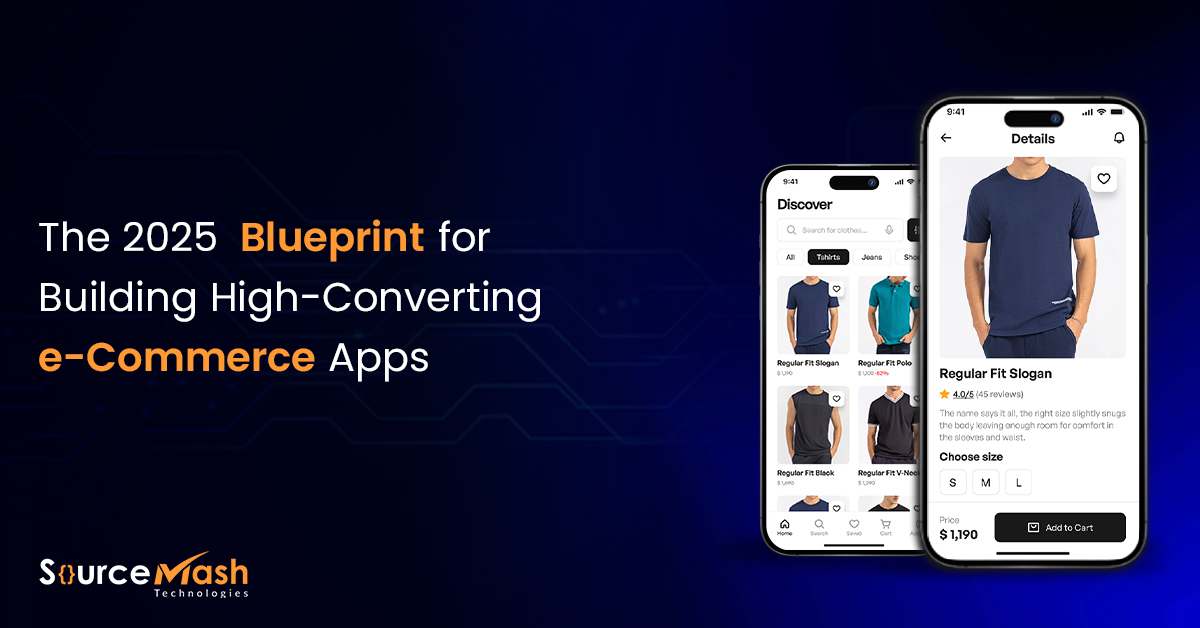
#App Development, Technology
The Complete Guide to eCommerce App Development in 2025
If you’re gearing up to build your eCommerce app, you already know one thing — customer experience is everything. But in 2025, the rules of the game are shifting faster than ever. The move from desktop browsing to mobile shopping is old news; now the market is evolving at lightning speed.
Gen Z is at the forefront of this change. Nearly three-quarters (74%) of this digitally native generation shop through mobile apps, and they’re quickly becoming the dominant consumer group. Even among Millennials, 75% of B2B decision-makers say they would switch to a different supplier if they were offered a better digital experience.
Why Invest in eCommerce App Development?
Market trends alone aren’t enough to justify an investment — entrepreneurs want hard reasons. Here are three compelling, long-term drivers that make eCommerce app development a smart move.
1. Boosted Profit Margins
Mobile shoppers are worth more — data shows they have a lifetime value up to three times higher than web-only customers. Beyond direct sales, your app can generate revenue through in-app purchases, subscriptions, sponsored content, and other monetization models. Pair this with effective CRO (conversion rate optimization) strategies, and you can significantly lift sales.
2. Sustainable Growth
The pandemic accelerated mobile adoption, and there’s no going back. A high-quality eCommerce app keeps your brand in customers’ hands — literally — and embedded in their daily purchasing habits.
3. Evergreen Market Demand
No matter the economic climate or tech trends, people will always buy and sell. While preferences may shift, the basic act of trade remains constant, making eCommerce a stable, long-term business model.
The Four Main Types of eCommerce Apps
Not all eCommerce apps work the same way. The right type depends on your business model.
B2B (Business-to-Business)
Designed for transactions between companies, often featuring bulk ordering, invoicing, and inventory management.
Examples: Alibaba, Grainger.
B2C (Business-to-Consumer)
Direct sales to individual buyers, with user-friendly navigation, multiple payment options, and personalized experiences.
Examples: Amazon, Sephora.
C2C (Consumer-to-Consumer)
Enables individuals to sell directly to each other, often through auctions, classifieds, or resale platforms.
Examples: eBay, Etsy.
C2B (Consumer-to-Business)
Let individuals offer services or content to companies, such as freelance platforms or stock photo sites.
Examples: Upwork, Shutterstock.
Essential Features Every eCommerce App Needs
Developing an e-commerce app requires thoughtful prioritization of features. While having a standout “killer” feature can set your app apart, especially in an MVP, the real impact comes from getting the fundamentals right. Focus first on core functionalities — this is where you’ll maximize value and ensure your MVP delivers a solid, user-friendly experience.
Product Catalog: Displays all products in an organized way, allowing users to search, filter, and explore details easily.
Shopping Cart: Let customers add or remove items, apply discounts, and see total costs in real time for a smooth checkout.
Secure Payments: Offers multiple safe payment options, including cards, digital wallets, and QR codes, ensuring trust and convenience.
Order Management: Tracks order status, delivery updates, and purchase history, keeping customers informed.
User Accounts: Stores preferences, order history, and payment info to speed up repeat purchases and enhance personalization.
Product Reviews: Enables customer ratings and feedback, helping build credibility and guide buying decisions.
Advanced Features for Next-Level Apps

Once your eCommerce app covers the basic functions—the backbone of your business—it’s time to level up and bring in the latest tech to make shopping smarter, faster, and more enjoyable. Here’s how:
Augmented Reality (AR) Integration
Let customers virtually “try on” or preview products from home. AR technology gives shoppers a realistic view of items, making it easier to decide, boosting confidence, and reducing returns.
Artificial Intelligence (AI) Assistance Chatbots and virtual assistants can answer questions around the clock, guide users through delivery or service details, and reduce support costs. Quick, helpful responses keep customers engaged and less likely to abandon their cart.
“Buy Now, Pay Later” (BNPL)
Give shoppers flexible payment options. BNPL lets customers pay in installments rather than upfront, offering more financial control and making larger purchases easier.
Geo-Location Services
Personalize the shopping experience using location data. Show nearby store availability, recommend products based on preferences, and send geo-targeted promotions to make every interaction relevant.
Of course, each feature should be chosen thoughtfully. But when done right, these tools create a seamless, anticipatory, and convenient shopping experience—turning your app from just functional into truly revolutionary.
The 6-Step eCommerce App Development Process
Developing an e-commerce app, whether for mobile or web, requires careful planning and smooth execution. To give your startup the best chance of success, it’s important to follow the key steps below while adapting them to your specific project needs.
Step 1: Market Research and Planning
Start by understanding your audience. Who are your customers, and what do they really want? Dive into competitor analysis and audience insights to create an app that stands out. Make sure your app delivers real value and translates these insights into clear business requirements.
Pro tip: A discovery phase helps validate your ideas and ensures your app meets actual market needs.
Step 2: Define Features and Functionality
Build your MVP with focus and simplicity. Stick to the core purpose of your app, ensure intuitive navigation, responsive design, and strong security. Prioritizing the essentials makes development smoother and faster.
Step 3: Choose the Right Technology Stack
Pick a tech stack that supports speed, scalability, and easy integration. Options like React Native or Flutter work well for mobile, while React and Node.js handle web and backend efficiently.
Pro tip: Choose tools that make third-party integrations easy to keep your platform flexible and future-ready.
Step 4: UI/UX Design
Create a user-friendly design that reflects your brand and makes shopping seamless. Focus on clear navigation, responsive layouts, and accessibility so every user feels valued.
Pro tip: Early wireframes and prototypes can save time and reduce design costs.
Step 5: Development and Testing
Work collaboratively between front-end and back-end teams. Test thoroughly with unit, integration, and user acceptance testing to catch bugs and ensure security.
Pro tip: Use CI/CD practices to speed up deployment and maintain app stability.
Step 6: Launch and Support
Launch your app confidently, but remember the work doesn’t stop there. Ongoing support is crucial for fixing issues, improving user experience, and building long-term loyalty.
eCommerce App Development Costs
Developing an e-commerce app is a significant investment, and the cost depends on several factors. Generally, businesses choose between two approaches: building an MVP (Minimum Viable Product) or creating a full-featured, advanced app.
MVP eCommerce App Cost
A basic MVP usually starts around $50K–$70K. This version includes essential features like user accounts, product listings, a shopping cart, and payment processing.
eCommerce App Development Costs
Developing an e-commerce app is a significant investment, and the cost depends on several factors. Generally, businesses choose between two approaches: building an MVP (Minimum Viable Product) or creating a full-featured, advanced app.
MVP eCommerce App Cost
A basic MVP usually starts around $50K–$70K. This version includes essential features like user accounts, product listings, a shopping cart, and payment processing.
Final Takeaway
In the competitive eCommerce landscape, your mobile app is no longer just an add-on — it’s the core of customer experience. By combining essential features, forward-looking tech, and a thoughtful development process, you can create an app that not only meets user expectations but exceeds them.
Partnering with an experienced eCommerce app development company like Sourcemash ensures you avoid costly mistakes, accelerate time-to-market, and position your business for long-term success.




 MOHALI - HQ
MOHALI - HQ
 BANGKOK
BANGKOK
 TORONTO
TORONTO
 NEW YORK
NEW YORK
 BENGALURU
BENGALURU